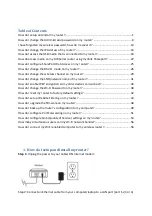
Reference Manual for the 54 Mbps Wireless Travel Router WGR101
D-6
Wireless Networking Basics
February 2005 (202-10034-03)
WEP Shared Key Authentication
This process is illustrated in below.
Figure D-2: 802.11 shared key authentication
The following steps occur when two devices use Shared Key Authentication:
1.
The station sends an authentication request to the access point.
2.
The access point sends challenge text to the station.
3.
The station uses its configured 64-bit or 128-bit default key to encrypt the challenge text, and
sends the encrypted text to the access point.
4.
The access point decrypts the encrypted text using its configured WEP Key that corresponds
to the station’s default key. The access point compares the decrypted text with the original
challenge text. If the decrypted text matches the original challenge text, then the access point
and the station share the same WEP Key and the access point authenticates the station.
5.
The station connects to the network.
If the decrypted text does not match the original challenge text (i.e., the access point and station do
not share the same WEP Key), then the access point will refuse to authenticate the station and the
station will be unable to communicate with either the 802.11 network or Ethernet network.
I N TER N ET
LO C A L
ACT
1
2
3
4
5
6
7
8
LNK
LNK/ACT
100
Cable/DSL
ProSafe Wireless VPN Security Firewall
MODEL
FVM318
PWR
TEST
W LA N
Enable
Access Point
1) Authentication
request sent to AP
2) AP sends challenge text
3) Client encrypts
challenge text and
sends it back to AP
4) AP decrypts, and if correct,
authenticates client
5) Client connects to network
Shared Key
Authentication Steps
Cable or
DLS modem
Client
attempting
to connect
Содержание WGR101
Страница 6: ...February 2005 202 10034 03 vi...
Страница 14: ...Reference Manual for the 54 Mbps Wireless Travel Router WGR101 4 About This Manual February 2005 202 10034 03...
Страница 22: ...Reference Manual for the 54 Mbps Wireless Travel Router WGR101 2 8 Introduction February 2005 202 10034 03...
















































